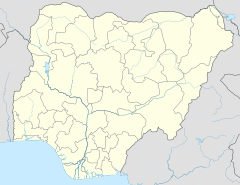Pandam Wildlife Park
| Pandam Wildlife Park | ||
|---|---|---|
|
|
||
| Location: | Nigeria | |
| Specialty: | Nassarawa state , plateau | |
| Surface: | 197.42 km² | |
| Founding: | 1972 | |
The Pandam Wildlife Park is a nature reserve in the area of Nigerian states Nassarawa and Plateau .
location
The protected area covers an area of 197.42 km² in the south of the belly plateau . It lies at an altitude of 175 to 310 meters above sea level and is bounded to the north and west by the Dep River, a tributary of the Ankwe , and to the south and east by the settlements of Pandam, Namu, Kayarda and Aningo. The terrain in the park generally slopes down to the south and forms a basin in which Lake Pandam is located. This is about 150 meters wide and about three kilometers long and has three tributaries, Kurmi, Dogon and Zurzurfar. In the dry season, the lake has no drainage and is only connected to the Dep River via its extensive floodplains in the rainy season. The closest metropolitan areas are Shendam , Wase, and Pan Quan .
development
The Pandam Wildlife Park was added to the list of wetlands of international importance by the Ramsar Convention on April 30, 2008 under the title Pandam and Wase Lakes Wildlife Park . Originally the area was established in 1972 under the title Dep River Forest Reserve. It is administered by the Nassarawa State Department of Agriculture and Forestry.
The Pandam Wildlife Park has great tourist potential and is an example of the gentle development of tourism in Nigeria. In 2004 over 27,000 visitors were counted.
climate
The climate is tropical and humid, with a rainy season from April to October and a dry season from November to March. The average amount of precipitation is about 1200 to 1500 mm per year, with the months of August and September, at the height of the West African monsoons , being the rainiest. The dry months are determined by the north-east Passat Harmattan blowing from the Sahara . Average daily temperatures range from 25 ° C in August to 35 ° C in March.
flora
The flora in the Ramsar Conservation Area is characterized by a pronounced savannah landscape in Sudan and in the south of the Guinea savannah zone, which are interspersed with extensive forests and alternate with gallery forests along the rivers in the valleys. A total of 152 species of vascular plants from 52 genera or families were registered in the park . The most important tree species in the savannah zones include Burkia africana , Dentarium microcarpum , Combretum glutinosum , Isoberlinia doka , Parkia biglobosa , Butyrospermum paradoxon , Daniellia oliveri and Gardenia aqualla . The tree species Afzelia africana , Ceiba pentandra and Raphia sudanica are found in the gallery forests .
fauna
The mammalian fauna includes the roan antelope ( Hippotragus equinus ), the Cape buffalo ( Syncerus caffer ), the brush-eared pig ( Potamochoerus porcus ) and the waterbuck ( Kobus ellipsiprymnus ). The lake and its tributaries include the hippopotamus ( Hippopotamus amphibius ), the African manatee ( Trichechus senegalensis ) and the Nile crocodile ( Crocodylus niloticus ).
The avifauna in the park is considered to be very species-rich: a total of 219 bird species could be observed. These include numerous water birds and migratory birds from the northern hemisphere that use the park as winter quarters.
The fish fauna in the waters includes 29 species of fish from 18 species. These include various types of tilapia , African bone- winged fish ( Heterotis niloticus ), African high- backed tetra ( Citharinus citharus ) and smaller populations of the puffer fish Tetraodon lineatus and Labeo senegalensis , Nile perch ( Lates niloticus ) and trembling catfish ( Malapterurus electricus ).
Individual evidence
- ↑ WETLAND WILDLIFE RESOURCES OF NIGERIA FAO publication (English)
- ↑ The Annotated Ramsar List: Nigeria (English)
- ↑ HM Ijeomah & GU Emelue: ECOTOURISM MANAGEMENT AND SUSTAINABLE UTILIZATION OF BIODIVERSITY IN PANDAM WILDLIFE PARK, NIGERIA published in Journal of Sustainable Development in Africa (Volume 11, No. 2, 2009) (PDF document; 268 kB) (English)
- ↑ Henry Mm aduabuchi Ijeomah: Impact OF TOURISM ON LIVELIHOOD OF COMMUNITIES ADJOINING ECODESTINATIONS IN PLATEAU STATE, NIGERIA ( Memento of the original from October 22, 2013 in the Internet Archive ) Info: The archive link was automatically inserted and not yet checked. Please check the original and archive link according to the instructions and then remove this notice. (PDF document; 402 kB) (English)
- ↑ Ogunkoya & Dami: Information Sheet on Ramsar Wetlands (RIS) - 2006-2008 Version ( Memento of the original from March 4, 2016 in the Internet Archive ) Info: The archive link was inserted automatically and has not yet been checked. Please check the original and archive link according to the instructions and then remove this notice. on Wetlands.org (PDF document; 129 kB) (English)
- ↑ C. Akosim, BT Kwaga, A. Ali and GS Mamman: Flora Resources and Structure in Pandam Wildlife Park, Pandam, Plateau State, Nigeria published in Agricultural Journal, 2/2007 pages 740-747 (English)
- ↑ NG009. Pandam Wildlife Park on BirdLife International (English)
- ↑ C. Akosim, BT Kwaga, B. Umar and GS Mamman: The Role of Aquatic Bodies in Avifauna and Fish Conservation in Pandam Wildlife Park, Pandam, Plateau State, Nigeria Journal of Fisheries International, 3/2008, pages 7-11 (English )

